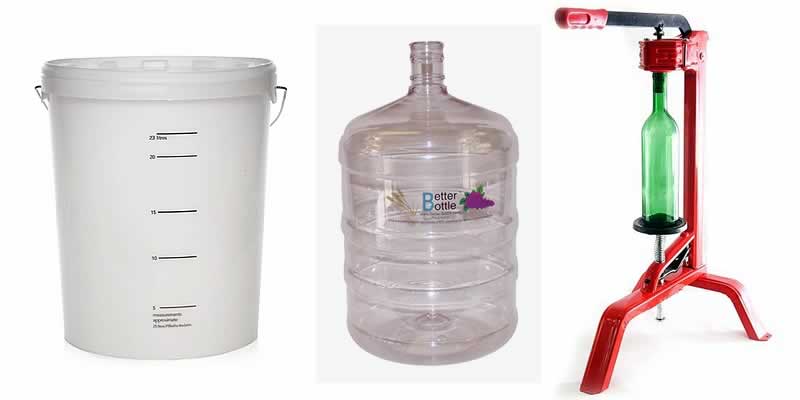
Winemaking Equipment
It's easy to start making wine. You need only a small area with running water and a minimal amount of equipment. Most of the equipment is made from food-grade plastic so i's durable and light-weight and easy to work with. You can get your own mini winery set up for less than a hundred dollars. However there are items you can add to your initial set-up as you proceed.
Essentials
There is some equipment that is essential if you want to make quality wine. Here is a list of what we've determined to be absolutely necessary if you want to make consistently good wine.
Food-grade plastic fermenting pail
You'll need a 30 litre or larger food-grade plastic pail with a lid. This is used to mix ingredients and conduct the initial fermentation. It's important that this is a new unused pail. Recycled pails may be contaminated and flavours and odours that will be transferred to your wine. Over the years we've seen many batches of wine and hours of worked been dumped down the drain because someone used a contaminated pail.
Plastic or glass carboy
A carboy is used for the second stage of fermentation. During this period your wine finishes fermentation and the clearing process takes place. It's important that you keep air from your wine at this stage or your wine may spoil. Carboys are filled to the neck and an air-lock is attached so the fermenting gas can escape but air cannot enter.
Air-lock
An air-lock is small, inexpensive peice of equipment but is maybe the most important item in your winery. It is essentially a plastic vial that is filled with water. The air-lock is inserted into a rubber stopper which is then used to seal your fermenting vessel. The water in the air-lock acts as a one-way valve. The fermenting gas bubbles up through the water but it stops air from entering.
Food-grade plastic tubing
You will need flexible and rigid plastic tubing for transferring your wine to the carboy and bottles. Again it's crucial that you use new tubing that has been approved for food contact.
Plastic or stainless steel spoon
You will need a spoon for stirring your juice. This should have a long handle and be made from either plastic or stainless steel. Do not use wooden spoons. They are very hard to sanitize and may spoil your wine. We prefer a plastic spoon because stainless can damage your plastic pail. If your pail becomes scratched it will make it more difficult to sanitize and will have to be replaced. Make sure your spoon is 18 inches or longer.
Thermometer and Hydrometer
These two instruments are important if you want consistent results. They eliminate guesswork and give you peace-of-mind.
Fermentation has to be conducted at certain temperatures here's where a thermometer proves to be invaluable. Use your thermometer to check the temperature of your juice before adding the yeast. If the juice is too warm it will weaken or destroy the yeast. If it's too cold the fermentation will be sluggish and may not finish. You'll also need a thermometer during the fermentation to make sure the temperature is optimal.
An hydrometer is used to measure the specific gravity of your juice. This will tell you how much sugar is in the juice and give you an idea of what the alcohol content will be in the finished wine. A hydrometer is a useful tool since it can be used to monitor the rate of fermentation and it will let you know when the fermentation is complete which is very comforting for new winemakers.
Nonessentials
The items listed below are not necessary to make good wine but they can make life much easier for you. You can save loads of time and get more enjoyment from your craft if you have these items on hand.
Corking Machine
A corking machine is necessary if you want to cork your bottles. You can also use screw-top bottles which take a cap that doesn't require a corking machine. A corking machine works by compressing the cork while simultaneously inserting it into the bottle.
FastRack or Bottle Tree
These are used to hold your inverted bottles in place while they drain. They are compact and take up far less space than spreading your bottles all over your working area. The FastRack also acts as a storage solution for your empty bottles.
Wine Degassing Rod
Wine kits are made in a short period of time compared to traditional winemaking and are ready to bottle in 4 to 6 weeks. This short period of time doesn't allow all the trapped carbon dioxide gas to escape so we need to help it on it's way. You can shake your carboy; try to beat the gas out with a spoon or you can use a wine degassing rod. The degassing rod attaches to your electric drill and makes short work of degassing. It reduces labour and degasses your wine in minutes.
Sulphiter
A sulphiter is essentially a bowl with a manual pump. You fill the bowl with a sanitizing solution and pump it into an inverted wine bottle. This is the fastest way to sanitize your wine bottles.
Carboy Cleaner
After fermentation is complete your carboy is covered in residue from the yeast and other particles. This can be hard to remove, especially if it accumulates up around the neck. The Carboy Cleaner attaches to an electric drill and reaches all areas of your carboy making cleaning a snap.
Heating Belt or Wrap
It's not economical to heat a whole room to keep your fermentation at the proper temperature. Here's where a heating belt saves you big bucks. Wrap it around your fermenting vessel, plug it in and it will keep your wine at the optimal temperature even in an unheated room.
